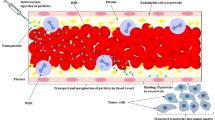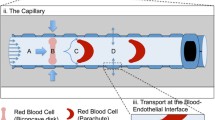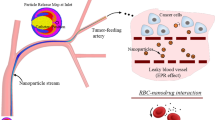Abstract
The character of nanoparticle dispersion in the microvasculature is a driving factor in nanoparticle-based therapeutics and bio-sensing. It is difficult, with current experimental and engineering capability, to understand dispersion of nanoparticles because their vascular system is more complex than mouse models and because nanoparticle dispersion is so sensitive to in vivo environments. Furthermore, uncertainty cannot be ignored due to the high variation of location-specific vessel characteristics as well as variation across patients. In this paper, a computational method that considers uncertainty is developed to predict nanoparticle dispersion and transport characteristics in the microvasculature with a three step process. First, a computer simulation method is developed to predict blood flow and the dispersion of nanoparticles in the microvessels. Second, experiments for nanoparticle dispersion coefficients are combined with results from the computer model to suggest the true values of its unknown and unmeasurable parameters—red blood cell deformability and red blood cell interaction—using the Bayesian statistical framework. Third, quantitative predictions for nanoparticle transport in the tumor microvasculature are made that consider uncertainty in the vessel diameter, flow velocity, and hematocrit. Our results show that nanoparticle transport is highly sensitive to the microvasculature.












Similar content being viewed by others
References
Bayarri MJ, Berger JO, Paulo R, Sacks J, Cafeo JA, Cavendish J, Lin CH, Tu J (2007) A framework for validation of computer models. Technometrics 49(2):138–254
Chen W, Allen JK, Tsui KL, Mistree F (1996) A procedure for robust design: minimizing variations caused by noise factors and control factors. ASME J Mech Des 118(4):478–485
Cabral H, Matsumoto Y, Mizuno K, Chen Q, Murakami M, Kimura M, Terada Y, Kano MR, Miyazono K, Uesaka M, Nishiyama N, Kataoka K (2011) Accumulation of sub-100 nm polymeric micelles in poorly permeable tumours depends on size. Nat Nanotechnol 6(12):815–823
Chauhan VP, Stylianopoulos T, Martin JD, Popovic Z, Chen O, Kamoun WS, Bawendi MG, Fukumura D, Jain RK (2012) Normalization of tumour blood vessels improves the delivery of nanomedicines in a size-dependent manner. Nat Nanotechnol 7(6):383–388
Duncan R (2006) Polymer conjugates as anticancer nanomedicines. Nat Rev Cancer 6(9):688–701
Dao M, Lim CT, Suresh S (2003) Mechanics of the human red blood cell deformed by optical tweezers. J Mech Phys Solids 51(1112):2259–2280
Decuzzi P, Godin B, Tanaka T, Lee SY, Chiappini C, Liu X, Ferrari M (2010) Size and shape effects in the biodistribution of intravascularly injected particles. J Controlled Release 141(3):320–327
Ferrari M (2005) Cancer nanotechnology: opportunities and challenges. Nat Rev Cancer 5(3):161–171
Jin R, Chen W, Simpson TW (2001) Comparative studies of metamodelling techniques under multiple modelling criteria. Struct Multidiscip Optimiz 23(1):1–13
Jin R, Chen W, Sudjianto A (2005) An efficient algorithm for constructing optimal design of computer experiments. J Stat Plan Inference 134(1):268–287
Kennedy MC, O’Hagan A (2001) Bayesian calibration of computer models. J R Stat Soc Ser B (Stat Methodol) 63(3):425–464
Kopacz AM, Liu WK (2013) Immersed molecular electrokinetic finite element method. Comput Mech 52(1):193–199
Kamoun WS, Chae S, Lacorre DA, Tyrrell JA, Mitre M, Gillissen MA, Fukumura D, Jain RK, Munn LL (2010) Simultaneous measurement of RBC velocity, flux, hematocrit and shear rate in vascular networks. Nat Methods 7(8):655–660
Kopacz AM, Patankar NA, Liu WK (2012) The immersed molecular finite element method. Comput Methods Appl Mech Eng 233–236:28–39
Liu Y, Liu WK (2006) Rheology of red blood cell aggregation by computer simulation. J Comput Phys 220(1):139–154
Lee S, Chen W (2009) A comparative study of uncertainty propagation methods for black-box-type problems. Struct Multidiscip Optimiza 37(3):239–253
Liu WK, Liu Y, Farrell D, Zhang L, Wang XS, Fukui Y, Patankar N, Zhang Y, Bajaj C, Lee J, Hong J, Chen X, Hsu H (2006) Immersed finite element method and its applications to biological systems. Comput Methods Appl Mech Eng 195(1316):1722–1749
Liu WK, Kim DW, Tang S (2007a) Mathematical foundations of the immersed finite element method. Comput Mech 39(3):211–222
Liu Y, Liu WK, Belytschko T, Patankar N, To AC, Kopacz A, Chung JH (2007b) Immersed electrokinetic finite element method. Int J Numer Methods Eng 71(4):379–405
Lee TR, Chang YS, Choi JB, Kim DW, Liu WK, Kim YJ (2008) Immersed finite element method for rigid body motions in the incompressible Navier–Stokes flow. Comput Methods Appl Mech Eng 197(2528):2305–2316
Lee S, Chen W, Kwak B (2009) Robust design with arbitrary distributions using gauss-type quadrature formula. Struct Multidiscip Optimiz 39(3):227–243
Lee TR, Choi M, Kopacz AM, Yun SH, Liu WK, Decuzzi P (2013) On the near-wall accumulation of injectable particles in the microcirculation: smaller is not better. Sci Rep 3. doi:10.1038/srep02079
Namdee K, Thompson AJ, Charoenphol P, Eniola-Adefeso O (2013) Margination propensity of vascular-targeted spheres from blood flow in a microfluidic model of human microvessels. Langmuir 29:2530–2535
Peer D, Karp JM, Hong S, Farokhzad OC, Margalit R, Langer R (2007) Nanocarriers as an emerging platform for cancer therapy. Nature Nanotechnol 2(12):751–760
Park Y, Best C, Kuriabova T, Henle ML, Feld MS, Levine AJ, Popescu G (2011) Measurement of the nonlinear elasticity of red blood cell membranes. Phys Rev E 83(051):925
Simpson TW, Martin JD, Booker AJ, Giunta AA, Haftka RT, Renaud JE, Kleijnen JPC (2005) Use of kriging models to approximate deterministic computer models. AIAA J 43(4):853–863
Sinek J, Sanga S, Zheng X, Frieboes H, Ferrari M, Cristini V (2009) Predicting drug pharmacokinetics and effect in vascularized tumors using computer simulation. J Math Biol 58:485–510
Saadatmand M, Ishikawa T, Matsuki N, Abdekhodaie M, Imai Y, Ueno H, Yamaguchi T (2011) Fluid particle diffusion through high-hematocrit blood flow within a capillary tube. J Biomech 44(1):170–175
Tan J, Thomas A, Liu Y (2012) Influence of red blood cells on nanoparticle targeted delivery in microcirculation. Soft Matter 8:1934–1946
van de Ven AL, Kim P, Haley O, Fakhoury JR, Adriani G, Schmulen J, Moloney P, Hussain F, Ferrari M, Liu X, Yun SH, Decuzzi P (2012) Rapid tumoritropic accumulation of systemically injected plateloid particles and their biodistribution. J Controlled Release 158(1):148–155
Zhang L, Gerstenberger A, Wang X, Liu WK (2004) Immersed finite element method. Comput Methods Appl Mech Eng 193(2122): 2051–2067
Zhang J, Johnson P, Popel AS (2008) Red blood cell aggregation and dissociation in shear flows simulated by lattice boltzmann method. J Biomech 41(1):47–55
Acknowledgments
W.K.L. acknowledges the support of CMMI-0856492 and CMMI-0856333. This research used resources of the QUEST cluster at Northwestern University and the Argonne Leadership Computing Facility at Argonne National Laboratory, which is supported by the Office of Science of the U.S. Department of Energy under contract DE-AC02-06CH11357. W.K.L. acknowledges the support of the World Class University Program through the National Research Foundation of Korea (NRF) funded by the Ministry of Education, Science and Technology (R33-10079). M.S.G. warmly thanks the National Science Foundation GRFP program for their support. Z.J. and W.C. are supported by the National Science Foundation Grant CMMI-1233403. P.D. acknowledges the partial support by the Cancer Prevention Research Institute of Texas (CPRIT RP110262) and the USA National Cancer Institute (U54CA143837 and U54CA151668).
Author information
Authors and Affiliations
Corresponding author
Rights and permissions
About this article
Cite this article
Lee, TR., Greene, M.S., Jiang, Z. et al. Quantifying uncertainties in the microvascular transport of nanoparticles. Biomech Model Mechanobiol 13, 515–526 (2014). https://doi.org/10.1007/s10237-013-0513-0
Received:
Accepted:
Published:
Issue Date:
DOI: https://doi.org/10.1007/s10237-013-0513-0




